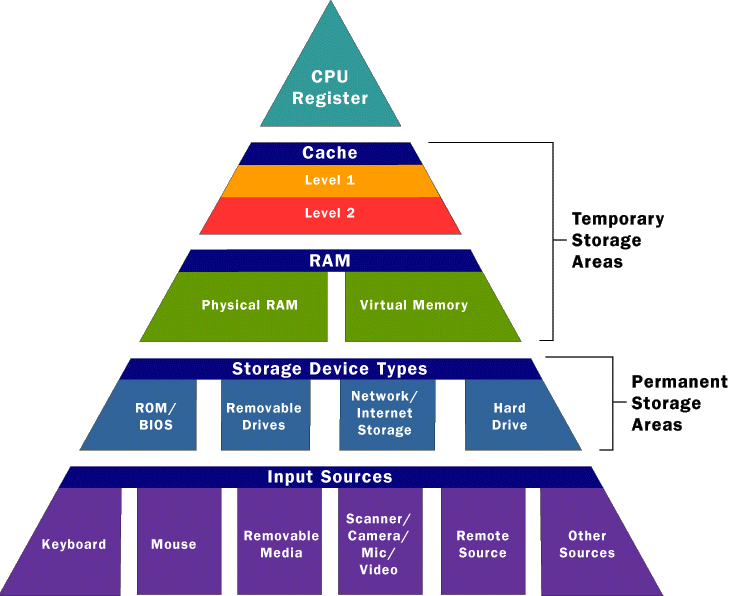
Memory
Is at the Heart of Your Computer
Although memory is technically any form of electronic storage, it is used most
often to identify fast, temporary forms of storage. If your computer's CPU had
to constantly access the hard drive to retrieve every piece of data it needs,
it would operate very slowly. When the data are kept in memory, the CPU can
access data much more quickly. Most forms of memory are intended to store data
temporarily.

As you can see in the diagram above, the CPU accesses memory
according to a distinct hierarchy. Whether it comes from permanent
storage (the hard drive) or input (the keyboard), most data goes in
random access memory (RAM) first. The CPU then stores pieces
of data it will need to access often in a cache and maintains
certain special instructions in the register. We'll talk
about each of these later.
All of the components in your computer, such as the CPU, the hard drive and
the operating system, work together as a team, and memory is one of the most
essential parts of this team. From the moment you turn your computer on until
the time you shut it down, your CPU is constantly using memory. Let's take a
look at a typical scenario:
- You turn the computer on.
- The computer loads data from read-only memory (ROM) and
performs a power-on self-test (POST) to make sure all the
major components are functioning properly. As part of this test,
the memory controller checks all of the memory addresses
with a quick read/write operation to ensure that there are
no errors in the memory chips. Read/write means that data is
written to a bit and then read from that bit.
- The computer loads the basic input/output system (BIOS) from ROM.
The BIOS provides the most basic information about storage devices, boot sequence,
security, Plug and Play (auto device recognition) capability and a
few other items.
- The computer loads the operating system (OS) from the
hard drive into the system's RAM. Generally, the critical parts of
the OS are maintained in RAM as long as the computer is on. This
allows the CPU to have immediate access to the OS, which enhances
the performance and functionality of the overall system.
- When you open an application, it is loaded into RAM. To
conserve RAM usage, many applications load only the essential
parts of the program initially and then load other pieces as
needed.
- After an application is loaded, any files that are opened for
use in that application are loaded into RAM.
- When you save a file and close the application, the file is
written to the specified storage device, and then it and the
application are purged from RAM.
In the list above, every
time something is loaded or opened, it is placed into RAM. This
simply means that it has been put in the computer's temporary
storage area so that the CPU can access that information more
easily. The CPU requests the data it needs from RAM, processes it
and writes new data back to RAM in a continuous cycle. In most
computers, this shuffling of data between the CPU and RAM happens
millions of times every second. When an application is closed, it
and any accompanying files are usually purged (deleted) from RAM to
make room for new data. If the changed files are not saved to a
permanent storage device before being purged, they are lost.
 |
 |


